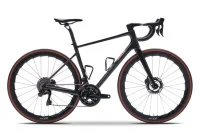Bearing Grades and Quality
A version![]() of this article was originally
of this article was originally
published in Triathlete Magazine
In the April 2009 issue of Triathlete, in the Tech Support column, there was an article that mentioned ceramic (hybrid) bearings and recommended a Grade 3 bearing or better. From the Internet, I found that some manufacturers say Grade 5 bearings are the best to get (for cycling applications), while others say Grade 3 is the best. If Grade 3 bearings are the best, does that mean that the Grade 5 Ceramic bearings used in my FSA bottom bracket and HED FR wheels are no better than a steel bearing? Thank you.
Jack, Louisiana
Dear Jack,
ABEC Grade 5 bearings are actually better than Grade 3 and Grade 3 was the minimum grade recommended in the article, so the bearings you have are some of the highest grade readily available in the cycling industry. The higher the ABEC grade of a bearing, the more symmetrical and tighter the tolerances of the rings (races) that hold the balls. Bearing ratings can be confusing and they only tell part of the story, thus some additional information may help.
Bearings in the cycling industry are rated by their ABEC grade and/or by their overall roundness in millions of an inch. Cartridge bearings are the most common type of bearings on bicycles and most companies usually rate by their ABEC grade over their millions of an inch grade. For this reason, I’ll discuss ABEC ratings first.
ABEC Rating: The “Annular Bearing Manufacturers Association” has a committee that sets standards for bearing precision called the “Annular Bearing Engineers Committee” – “ABEC”.
Cartridge bearings are the most common bearing type in the cycling industry. A “cartridge bearing” means that the balls, seals, grease and the internal and external races are all built into a single cartridge bearing unit that is usually press fit into the application. ABEC grading considers the precision of the rings (races) that the bearings roll on, but not the precision of the balls. The ABEC scale rates bearing precision on four levels: 1, 3, 5 and 7.
ABEC 1 is the lowest level of bearing that is considered “Precision”. ABEC 1 bearings are specified on three variables:
- Bore – The Inside Diameter of the bearing – also measured as the size of the shaft (inner cone) that the bearings revolve around.
- Radial Run Out – The roundness of the actual races.
- Ring Width Variation – The consistency of the width between the inner and outer bearing rings. The more consistent the ring width around the entire bearing, the smoother the balls can roll between the rings and the higher the precision.
ABEC 3 bearings are rated on the same three dimensions as ABEC 1, although at tighter tolerances. For example, an ABEC 1 bearing will have .0003mm of Radial Run Out (roundness variation), while an ABEC 3 has only .0002mm of variation.
ABEC 5 bearings not only have tighter tolerances on the three core variables above, but they must also adhere to set standards on additional dimensional items within the bearing as established by ABEC. These additional tolerances provide greater precision and lower rolling resistance. The differences between a Grade 3 and 5 bearing for cycling are noticeable and many companies use Grade 5 for this reason. Grade 7 bearings tighten the tolerances further still.
It is important to note that the ABEC rating system only applies to the tolerances that ABEC sets as standards and does not consider some other important variables that can affect bearing performance and durability. Ball tolerances, materials, grain structure, grease, seals and manufacturing environment are examples of things that are not taken into account by the ABEC ratings.
Millions of an Inch Rating: You may also see bearings listed anywhere from Grade 2 to Grade 1000 in the cycling industry. These parameters simply refer to how round the balls are in millions of an inch. In this rating system, the lower the number the better the quality of the bearing and the harder and better finished the bearing. For example, a Grade 25 is round to 25/1,000,000″, while a Grade 1000 is round only to 1000/1,000,000″. For perspective, loose bearings found in a Shimano Dura Ace hub, would often be Grade 25.
So, what do you need to know when you are selecting bearings for cycling?
If you are looking at loose bearings graded between 2 and 1000, get the lowest number available for the application. The price difference is minimal between a Grade 25 and a Grade 300 or 1000 and the tighter tolerances and roundness of the bearings makes a notable difference in any rolling application (like hubs).
If you are looking at ABEC graded bearings, a Grade 1 bearing does not have very tight tolerances and performance will be limited. A Grade 3 is a significant step up from Grade 1, while a Grade 5 is where the performance “sweet spot” is located for cycling. This is why most ceramic and ceramic hybrid bearings for bicycles are Grade 5. Grade 7 bearings offer only a small gain in tolerances compared to Grade 5. The cost of a Grade 7 bearing can be up to ten times the cost of a Grade 5 bearing and would really only show further benefit in very high RPM mechanical applications (well beyond what can be achieved on a bicycle).
As mentioned above, because ABEC bearing grade only reflects precision of dimensions, you need to be careful that you still get what you want in other important aspects of bearing performance. For example, ABEC ratings don’t take materials or hardness into account and thus you can have an ABEC Grade 5 steel bearing, Grade 5 Ceramic or Grade 5 “hybrid” bearing.
Full ceramic bearings use ceramic balls and ceramic rings (races). Ceramic is significantly harder than steel, requires less lubrication and is lighter, so a top quality Ceramic bearing will offer less rolling resistance, greater durability and lower weight than a steel bearing of the same grade. Hybrid bearings are the most common type of “ceramic” bearings in the cycling industry. In a “Hybrid” bearing you will find ceramic balls rolling on steel races. So, look at the big picture and realize that if you want the full benefits of a Ceramic bearing system, you need to look beyond the grade and at the materials, the quality, and the fabrication of the bearing as well.
Hopefully this helps you select the right bearing for your needs and high quality Ceramic bearing technology is well worth considering if you are trying to maximize your performance and are upgrading a high precision component.
Ride hard and smart.
Ian
Thanks to Max Ralph at FSA for helping with this article.
Originally published August 2009/ Copyright © 2009
This article has been edited to reflect more accurate information on bearing performance since its writing. Search “bearing” in our website for articles with additional and newer information.









